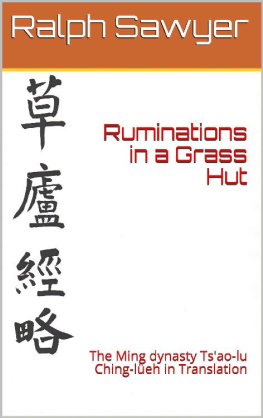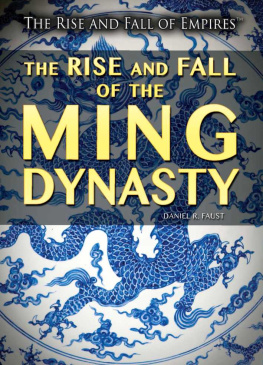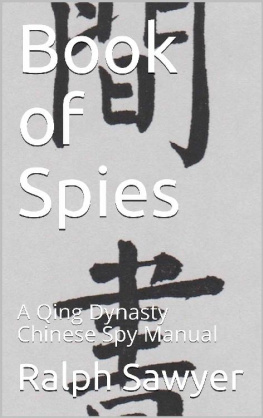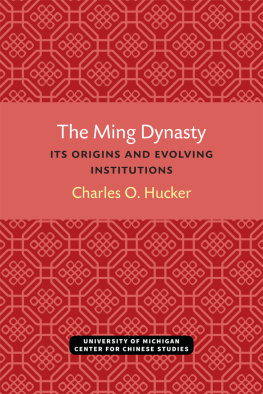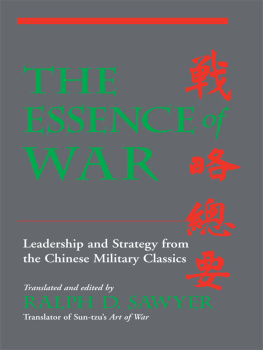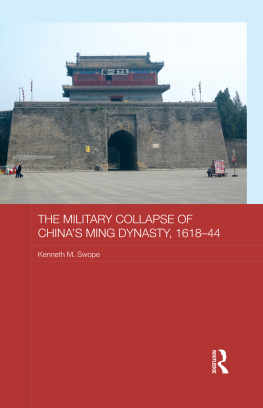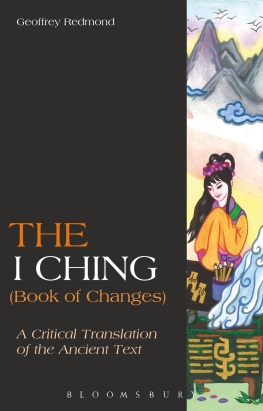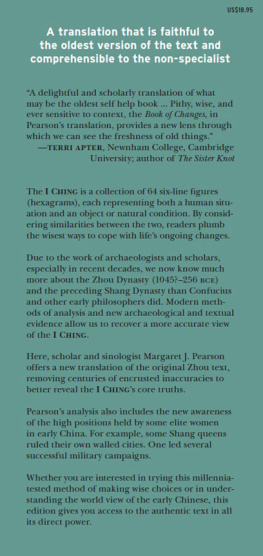Ralph Sawyer - Ruminations in a Grass Hut: The Ming dynasty Tsao-lu Ching-lüeh in Translation
Here you can read online Ralph Sawyer - Ruminations in a Grass Hut: The Ming dynasty Tsao-lu Ching-lüeh in Translation full text of the book (entire story) in english for free. Download pdf and epub, get meaning, cover and reviews about this ebook. year: 2020, genre: Politics. Description of the work, (preface) as well as reviews are available. Best literature library LitArk.com created for fans of good reading and offers a wide selection of genres:
Romance novel
Science fiction
Adventure
Detective
Science
History
Home and family
Prose
Art
Politics
Computer
Non-fiction
Religion
Business
Children
Humor
Choose a favorite category and find really read worthwhile books. Enjoy immersion in the world of imagination, feel the emotions of the characters or learn something new for yourself, make an fascinating discovery.
- Book:Ruminations in a Grass Hut: The Ming dynasty Tsao-lu Ching-lüeh in Translation
- Author:
- Genre:
- Year:2020
- Rating:4 / 5
- Favourites:Add to favourites
- Your mark:
- 80
- 1
- 2
- 3
- 4
- 5
Ruminations in a Grass Hut: The Ming dynasty Tsao-lu Ching-lüeh in Translation: summary, description and annotation
We offer to read an annotation, description, summary or preface (depends on what the author of the book "Ruminations in a Grass Hut: The Ming dynasty Tsao-lu Ching-lüeh in Translation" wrote himself). If you haven't found the necessary information about the book — write in the comments, we will try to find it.
Ralph Sawyer: author's other books
Who wrote Ruminations in a Grass Hut: The Ming dynasty Tsao-lu Ching-lüeh in Translation? Find out the surname, the name of the author of the book and a list of all author's works by series.
Ruminations in a Grass Hut: The Ming dynasty Tsao-lu Ching-lüeh in Translation — read online for free the complete book (whole text) full work
Below is the text of the book, divided by pages. System saving the place of the last page read, allows you to conveniently read the book "Ruminations in a Grass Hut: The Ming dynasty Tsao-lu Ching-lüeh in Translation" online for free, without having to search again every time where you left off. Put a bookmark, and you can go to the page where you finished reading at any time.
Font size:
Interval:
Bookmark:
Ruminations in a Grass Hut
The Ts'ao-lu Ching-leh in Translation
Translated by Ralph D. Sawyer
With the Collaboration of Mei-chn Lee Sawyer
Copyright 2020 Ralph D. Sawyer
All rights reserved
No part of this book may be reproduced, or stored in a retrieval system, or transmitted in any form or by any means, electronic, mechanical, photocopying, recording, or otherwise, without express written permission of the publisher.
Dedicated to the memory of Michael E. Hom
who long awaited its completion
Contents


Preface
The expansive Tsao-lu Ching-leh or Ruminations from a Grass Hut the grass hut being a reference to Chu-ko Liangs hermitage, ruminations our extended interpretation of ching-leh which basically means essential strategies is one of several seminal Ming dynasty (13681644) works that conclude Chinas pre-modern exploration of military concepts and doctrine, the others being manuals and meditations by experienced generals including Chi Chi-kuang, encyclopedic compilations such as the massive Wu-pei Chih , and the highly abstract Ping-fa Pai-yen or A Hundred Terms in the Art of War . Standing at the end of a continuous literate tradition that dates back to Sun-tzus Art of War , not to mention earlier theorists whose thinking has vanished or exists only in enigmatic fragments, through their analysis and explication the Tsao-lu Ching-leh and Ping-fa Pai-yen preserve the final realization of indigenous military thought prior to the subsequent introduction of Western military doctrine in the middle Ching and its rejection in the twentieth century in favor of German, Swedish, and British concepts and practice. However, in the context of the PRCs development of military science with unique Chinese characteristics, not only are these traditional concepts and tactical principles again being pondered for contemporary application, the Tsao-lu Ching-leh has become the subject of conscious study in various PRC military and political think tanks.
The book itself consists of 152 individualized discussions of strategic concepts and tactical principles organized into twelve loosely thematic but untitled sections bereft of further explanation. The author adopts the case study approach initiated by Tu Yus Tung-tien in the Tang dynasty by first introducing and explicating a particular subject, then illustrating it with several battles drawn from the two thousand or so recorded ones that arose across the great sweep of Chinese history. It thus imitates, and no doubt consciously models upon the late Sung dynasty, equally anonymous, Pai-chan Chi-leh , which I previously translated under the title One Hundred Unorthodox Strategies: Battle and Tactics of Chinese Warfare . However, Ruminations differs from the latter by appending anywhere from two to eight illustrative examples to each chapter for a total of just under six hundred, not counting summary mention of many other incidents, rather than just a single one.
Apart from their intrinsic value, on the assumption that Ruminations is the creation of a single writer that was preserved intact rather than a collaborative book or one that continued to undergo modification or expansion after the original authors death, these examples may provide important clues for dating the book. Based on statements in the text, scholars have long attributed the book to an unknown Ming dynasty military thinker who was thoroughly familiar with the martial writings produced over the centuries, as well as the essential historical works ranging from the Tsuo-chuan through the official dynastic histories and the great historical synthesis of pre Sung events penned by Ssu-ma Kuang, the Tzu-chih Tung-chien (Comprehensive Mirror to Aid in Government) , in the eleventh century. Whether he was a military official consigned to the capital, which seems probable, or served as a field commander during the Mings many clashes with various peripheral peoples, including the Mongols, remains unknown. However, irrespective of his background and employment, he somehow found the time to thoroughly study Chinese military history and extensively ponder the pronouncements of earlier writers.
Although guns and cannons had appeared and were beginning to be employed in the Ming, accounts of their use in Ruminations dont provide definitive clues for dating because they are functionally treated much the same as bows, crossbows, and catapults. The latest historical examples tend to be clustered early in the sixteenth century and the author speaks about his present era, three generations later than Emperor Kao-tsus reign (1368-1399), but the text extensively notes Chi Chi-kuangs (1528-1588) accomplishments in fending off Japanese pirates and quotes passages from Chis Hsin-shu , initially written during the 1560s. This would suggest he lived in the first decades of the seventeenth century, at the end of the Ming, except that some of the battle illustrations closely follow accounts preserved in the Ming dynasty volume of the Twenty-five Histories , a work that wasnt printed until 1739 AD. Therefore, even though numerous works on military accomplishments were circulating that the official Ming history may have drawn on, he would either have had to be working in the historical bureau and had access to a work in progress in the early Ching, or someone added or revised the Ming examples if he completed the book by the end of the sixteenth century. Irrespective of conclusions, the best known edition of the book didnt appear until 1850 AD. Its history prior to that date remains unknown, though it certainly circulated in handwritten copies.
Having been drawn from a wide range of clashes, some famous battles, others minor encounters, the illustrations span more than two thousand years roughly the mid seventh century BC Chou dynasty through the sixteenth century AD Ming and show great familiarity with the entire expanse of Chinese military history. Many stem from the Tang dynasty and from the relatively unknown Six Dynasties period which saw the devolution of central government control with the Later Hans (23-220 AD) collapse and the realms division into the three kingdoms from which the eras initial portion derives its name. Further fragmentation occurred within a century as powerful aristocratic families and peripheral foreign groups battled for mastery of China in the north. As the multiple contenders strove to subjugate each other and gain control of ever greater portions of the realm, the roughly two centuries of interminable conflict that followed inflicted horrendous suffering on the population at large as often massive field forces battled each other into virtual non-existence.
Being affected by the political and geostrategic context, as well as the ways and practices of warfare, every battle found in the illustrations entails enormous historical complexity. However, in another sense they are timeless abstractions that have been selected for their visible dynamics rather than their historicity or impact. Warfare changed greatly from the Spring and Autumn, a period of chariot based warfare in which the primary weapon was the dagger-axe, to the Ming when tubed gunpowder weapons guns and cannon were first employed, albeit on a somewhat limited scale since the crossbow was far more accurate and deadly in skilled hands than any musket, while cavalry had become a decisive component in the Han.
The author was also thoroughly familiar with the classic military writings, especially the Seven Military Classics , and various Tang and Sung compilations, though the examples considerably overlap less with those found in the Tung-tien and Wu-ching Tsung-yao than might be expected. The theoretical discussions repeatedly cite concepts and tactical principles initially articulated in the Art of War traditionally attributed to the semi-legendary Sun-tzu, thereby acknowledging the texts continued vibrancy and its importance in founding Chinese military science. Next in importance come the Liu-tao ( Six Secret Teachings ) and Wu-tzu , both Warring States works even though the former is traditionally associated with L Shang, otherwise known as the Tai Kung, who played a crucial role as a strategic adviser to Kings Wen and Wu during the Chous ascension to power.
Next pageFont size:
Interval:
Bookmark:
Similar books «Ruminations in a Grass Hut: The Ming dynasty Tsao-lu Ching-lüeh in Translation»
Look at similar books to Ruminations in a Grass Hut: The Ming dynasty Tsao-lu Ching-lüeh in Translation. We have selected literature similar in name and meaning in the hope of providing readers with more options to find new, interesting, not yet read works.
Discussion, reviews of the book Ruminations in a Grass Hut: The Ming dynasty Tsao-lu Ching-lüeh in Translation and just readers' own opinions. Leave your comments, write what you think about the work, its meaning or the main characters. Specify what exactly you liked and what you didn't like, and why you think so.

